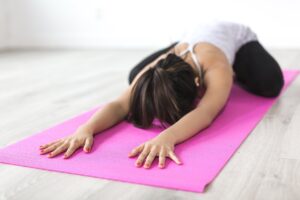
Yoga is more than a spiritual or mental practice. It is a complete fitness system that improves strength, stamina, and flexibility. Over the years, yoga has become one of the most popular ways to stay physically fit. From athletes to office workers, everyone can benefit from yoga. In this blog, we explore how yoga enhances physical fitness and flexibility.
Whether you’re a beginner or advanced practitioner, this 1000-word blog will help you understand the power of yoga in improving your body and overall well-being.
The Basics of Yoga
Yoga is an ancient practice that began in India over 5,000 years ago. It includes physical postures (asanas), breathing exercises (pranayama), and meditation. Today, yoga is practiced around the world for health and relaxation.
Translative thought: In simple terms, yoga brings balance to the body and peace to the mind.
Yoga Improves Strength
Yoga builds lean muscle. Many poses require you to hold your body weight in balance. This activates various muscle groups. For example, poses like Plank, Warrior, and Chair help build strength in the arms, legs, and core.
-
It tones the muscles.
-
It strengthens without lifting weights.
-
It improves posture and body alignment.
Key phrase: Yoga for strength training is a natural and low-impact way to tone your muscles.
Yoga Enhances Flexibility
Flexibility is one of yoga’s biggest benefits. Regular practice stretches your muscles and improves joint range of motion. This makes everyday movements easier and safer.
-
Poses like Downward Dog, Cobra, and Triangle stretch your spine, hips, and hamstrings.
-
Yoga reduces stiffness and tension.
-
Improved flexibility lowers the risk of injury.
Yoga Boosts Endurance
Yoga doesn’t just build muscle—it also builds endurance. Holding a pose for longer periods trains the body to work harder with less fatigue.
-
Builds cardiovascular strength in dynamic styles like Vinyasa and Power Yoga.
-
Improves breathing efficiency through pranayama (breath control).
-
Increases mental endurance by teaching focus and calmness.
Core Strength and Balance
A strong core supports the whole body. Yoga strengthens the core muscles through balance and stability-focused poses.
-
Boat pose, Plank, and Bridge pose all work the abdominal area.
-
Improved core strength supports the spine and prevents back pain.
-
Better balance reduces the risk of falls, especially in older adults.
Yoga and Weight Management
While yoga is not a high-intensity workout, it can support healthy weight loss and weight maintenance.
-
Reduces stress, which is a major cause of emotional eating.
-
Improves digestion through twisting poses and deep breathing.
-
Promotes mindfulness, helping you make better food choices.
Translative thought: A calm mind leads to a healthier body. Yoga helps you stay aware of your lifestyle habits.
Increases Mobility
Mobility is different from flexibility. It’s the ability to move freely and easily through your joints. Yoga helps increase mobility, especially in the hips, shoulders, and spine.
-
Active stretching in yoga improves joint function.
-
Prevents joint stiffness from sitting too long.
-
Keeps the body agile as you age.
Reduces Risk of Injuries
Tight muscles and weak joints increase the chance of injuries, especially in sports or everyday life. Yoga lowers this risk.
-
Strengthens stabilizing muscles.
-
Improves body awareness and alignment.
-
Encourages proper breathing to avoid strain.
Translative insight: When your body is flexible and strong, it can protect itself better.
Yoga for Athletes
Athletes use yoga to improve their performance and recovery. From runners to footballers, yoga supports high-level physical demands.
-
Speeds up muscle recovery after intense training.
-
Prevents overuse injuries.
-
Enhances focus and mental clarity.
Enhances Coordination and Body Awareness
Yoga improves neuromuscular coordination. It teaches you to control your body in space with precision and grace.
-
Boosts coordination and reflexes.
-
Helps with posture and alignment.
-
Improves the connection between mind and muscle.
Adaptable for All Fitness Levels
Yoga is suitable for everyone. It can be modified to fit all body types, ages, and levels of experience.
-
Gentle forms like Hatha or Yin Yoga are great for seniors or beginners.
-
Dynamic forms like Ashtanga or Power Yoga challenge advanced practitioners.
-
Props such as blocks and straps help modify poses safely.
Yoga Improves Breathing and Circulation
Breath is life. Yoga teaches conscious breathing, which boosts physical performance and health.
-
Deep breathing improves lung capacity.
-
Enhances oxygen delivery to muscles.
-
Regulates heart rate and blood pressure.
Mental Health and Physical Wellness
Yoga not only improves physical strength but also mental stability. A calm mind supports a healthy body.
-
Reduces cortisol levels (stress hormone).
-
Promotes better sleep, which aids recovery.
-
Boosts energy and motivation for regular workouts.
Real-Life Success Stories
Many people have transformed their bodies through yoga.
-
Office workers feel less back and neck pain.
-
Seniors report better mobility and balance.
-
Athletes recover faster and train harder.
Real-life impact adds proof to the power of yoga.
Conclusion: Yoga as a Total Body Workout
Yoga is not just stretching. It is a total body workout that builds strength, increases flexibility, improves balance, and boosts mental clarity. Whether you’re looking to get fit, stay flexible, or prevent injuries, yoga offers something for everyone.
With consistent practice, you’ll see changes in how your body moves, feels, and performs. Yoga is safe, sustainable, and suitable for every fitness level.
Final Thoughts
If you’re new to fitness or tired of high-impact workouts, give yoga a try. Your body and mind will thank you. Remember, you don’t need to be flexible to start yoga. You get flexible by doing yoga.
Start your yoga journey today. Just 20 minutes a day can make a huge difference.
